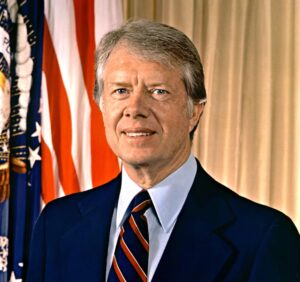In the fullness of time, our late 39th president, who died at 100 years old on Sunday, December 29, will never be mentioned among the giants of American history. In fact, the name of Jimmy Carter has, in the more than four decades since he departed the White House, been included in almost every conversation about the nation’s least effective chief executives.
After all, how can one put a gloss on a president whose legacy will forever be tarred with a landslide defeat in his bid for re-election? Only Herbert Hoover was kicked out of the White House with a similar degree of rejection.
And in both cases, it was the economy, stupid. In 1932, Hoover was overwhelmed by Franklin D. Roosevelt in the midst of the Great Depression. In 1980, Carter lost 45 states to Ronald Reagan in the vortex of a perfect storm of economic collapse rarely witnessed until the onset of the pandemic in 2020. It was called stagflation – a crushing mix of economic stagnation, punishing mortgage rates, and soaring inflation – a term now re-entering the political lexicon for the first time since Carter left the White House.
Four years earlier, in 1976, as a relatively obscure one-term governor from Georgia, Carter had launched his long-shot bid for the White House in the immediate aftermath of the Watergate scandal and the resignation of President Richard Nixon. He offered a one-two punch that gauged the mood of his party and the times with precision. With Democrats reeling from the landslide defeat of their disastrous left-wing nominee in 1972, George McGovern, Carter presented as a pragmatic centrist who would correct the party’s leftward lurch. At the same time, he proclaimed himself the Nixon antidote – an earnest outsider, a humble Christian man who would restore integrity to a corrupt and broken political system – as encompassed in his promise, “I’ll never lie to you.”
That’s not to say he was without self-assurance, as reflected in his campaign slogan: “Why Not the Best?” He recognized opportunity in the previously ignored Iowa caucuses, made a name for himself by winning that initial contest, and then cleverly navigated his way past a number of establishment politicians, all the way to the Democratic Party’s nomination and a narrow victory over President Gerald Ford.
Humility and Ambition
Carter arrived in DC leading with his own humility – best exemplified by carrying his own luggage – and a cadre of advisers from back home in Georgia. He was quickly schooled on the ways of Washington but refused to cozy up to the more liberal establishment of his own party, a decision which would cost him dearly. Like Donald Trump, he was always viewed as a threat by the entrenched DC establishment. It has been said that Democratic House Speaker Tip O’Neill, considered the most powerful man in Washington at the time, much preferred the company of President Reagan to that of President Carter.

Carter’s agenda was nothing if not ambitious. He had a hundred ideas on government reform, but his scattered leadership and lack of congressional support failed to focus the nation and build support for any individual initiative. He appeared often to be a defeatist, particularly in describing a national crisis he perceived in his infamous “malaise” speech (though he never used that actual word): “It is a crisis of confidence. It is a crisis that strikes at the very heart and soul and spirit of our national will.”
He tried to revive fireside chats, updated to include his signature cardigan, but they reminded no one of FDR. He put the slogan “the buck stops here” back on his Oval Office desk, but he was hardly confused with Harry Truman. Nothing he tried seemed to work.
While he continued to enjoy broad personal popularity, there was from the jump an enduring sense that the job was too big for the peanut farmer from Georgia, or that he was too small for it.
Triumph and Tragedy
The lone exception to Carter’s narrative of failure and weakness was the landmark peace agreement between Israel and Egypt, tirelessly negotiated over almost the entirety of Carter’s four years in office. It was the one concrete achievement of which he was always the most proud – and rightfully so, for it lowered the temperature of a broiling region for a time and brought to life the possibilities for actual peace in the Middle East, notwithstanding the predictable return to chaos that ensued. It ultimately led, decades later, to Donald Trump’s Abraham Accords.

President Jimmy Carter (Photo by: Photo12/Universal Images Group via Getty Images)
But a couple of other foreign policy decisions may have been just as responsible as the economy for Carter’s stunning demise. His epitaph will include the decision to withdraw from the 1980 Olympics in Moscow following the Soviet invasion of Afghanistan, which magnified his shortcomings as a leader. But worse yet was the utterly disastrous hostage crisis in Iran. After the pro-American Shah of Iran had been driven from power in 1979, radical Islamists took over the government, quickly stormed the US embassy in Teheran, and seized 52 Americans. Day after day, Americans were forced to endure “America Held Hostage: Day 50,” – or 100, or 250, etc – on their TV sets. A failed rescue attempt that left eight American servicemen dead in an Iranian desert likely put the final nail in the political coffin of an already reeling president. The hostages were held for 444 days, and in the final indignity heaped upon his failed presidency, they were finally released moments before Carter handed the keys to the Oval Office over to Reagan.
Such a sad legacy for a decent man with good intentions, yes? Well, not so fast.
Jimmy Carter’s Second Act
Famed author F. Scott Fitzgerald once wrote that there are no second acts in American lives, but Jimmy Carter disproved the theory as a former president. He took to his new status like a fish to water. In fact, it was almost as if Carter all along was running for his eventual role as ex-president, one in which he apparently discovered his true life’s calling: helping the poor.

(Photo by Paul Hennessy/NurPhoto via Getty Images)
He may have been a failed president, but he quickly pivoted to building a whole new branch on his tree of life, using his status to attract attention to works of human compassion. Habitat for Humanity (HFH) was barely a blip on the radar screen until the former president quietly picked up a shovel and worked shoulder-to-shoulder with ordinary volunteers for many long hours, building homes for the homeless. As per his long-pronounced faith, he was preaching the gospel, not with words but actions, hard labor. HFH is now a prominent fixture in the world of charity, as are several such organizations graced by the involvement of a man who could easily have profited handsomely from his former life but chose an entirely different mission. He was awarded the Nobel Peace Prize for his work with the Carter Center and its involvement in the alleviation of human suffering in 80 countries.
At the same time, the former president projected himself back onto the world political stage from time to time, serving in several capacities, from monitoring international elections to the dispensation of unsolicited advice to his successors.
In a remarkable coda to his life and a final act of survival worthy of the Carter narrative – parlaying disaster into triumph – Carter survived stage four metastatic cancer as a 91-year-old man, then went on to outlive his beloved wife of 77 years, Rosalynn, by more than a year.
Most men who have ascended to the position of leader of the free world have stories that may best be described as complicated. Not so Jimmy Carter. History will view him simply as an honorable man with good intentions who unfortunately fulfilled the Peter Principle in reaching his level of incompetence in the White House. But far from receding from public life in shame or regret, he rolled up his sleeves and parlayed his prominence not into personal enrichment like so many politicians, but into actually practicing what he had preached all along. May he rest in peace.

